Description
As intended here, housing as ‘infill and puntal interventions’ represents at least two kinds of site conditions and two different basic housing types. The first site condition involves the infilling of a prescribed street layout or similar infrastructural armature as new development with a succession of housing units, either completely or partially across the site and where the repetitive infilling may have one or more sequential orders. The second site condition, engaging ‘intervention’, usually implies redevelopment rather than infill
Infill and Puntal Interventions: Unit, type and use mixes
The American row house of the nineteenth century was often built as the more or less coterminous infill of street, block, and lot layouts comprising new sections of cities. The Back Bay of Boston, for instance, was an early version of a public-private joint venture in which the street layout and infrastructure, along with land reclamation, was provided with public support and the neatly-aligned rows of housing came at the hands of private developers. Typically, the row and terrace houses that were built were three storeys in height with additional half basement level and roof dormer accommodations on relatively narrow lots that stretched back to rear gardens and a service alley. In planar arrangement, stairs and services were usually concentrated in the middle with well-made rooms to the front and back, particularly on the
[1]
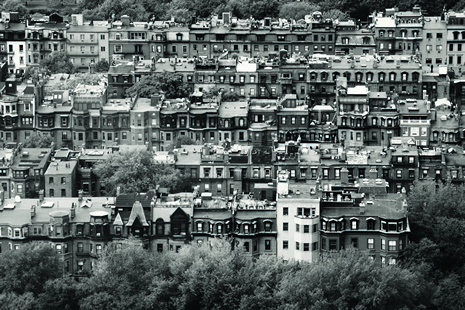
Boston Back Bay bow fronts
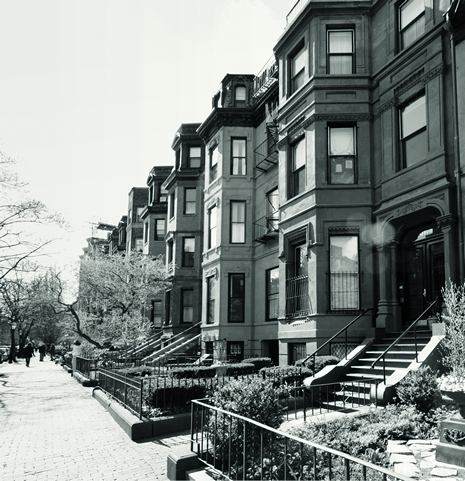
Boston Back Bay bow fronts
Mainly built in the 1860s through 1880s, the row offered varied architectural inflections and decorative programs on the façades, reifying particular figural tastes of the time. Similarly, row houses in Philadelphia, built somewhat earlier, show similar conformations, although with more sober façades. Also, the ‘brownstones’ of New York, built mainly towards the turn of the nineteenth into the twentieth centuries and even later, followed suit with respect to the basic row house type, but often with well- modeled façades and entry stairways, again reflecting architectural tastes of the time.
[2]
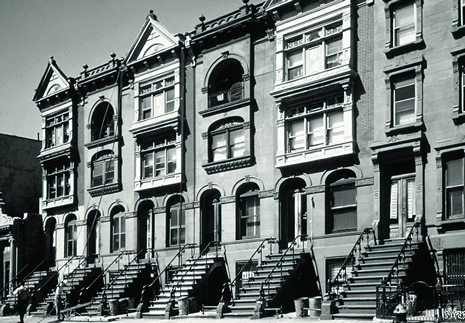
New York brownstones
Among cases of infill housing in the form of singular or puntal interventions, one of the most unusual is the ‘house under a house’ known as Maison de Verre in the Saint-Germain-des-Prés district of Paris in France. Designed and built by Pierre Chareau in collaboration with Bernard Bijvoet between 1927 and 1932, the Maison de Verre became one of the icons of the modern movement in architecture. Located in a courtyard owned by the Vellay family, the apartment with a doctor’s office included was a wedding gift to their daughter on the occasion of her marriage to Dr. Dalsace. However, a renter above would not move out. Hence, the building at the back of the courtyard, facing the entrance, was gutted out below the recalcitrant renter and the Maison de Verre inserted.
[3]
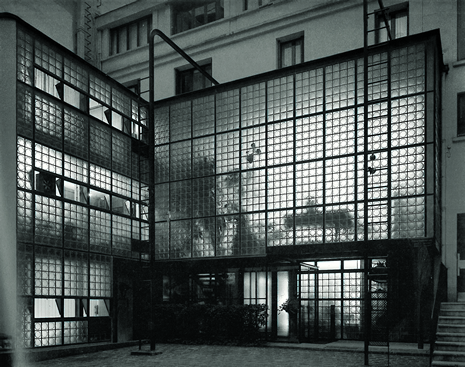
Maison de Verre, Paris
Pierre Chareau with Bernard Bijvoet, 1927-1932
As another example of infill and singular intervention, the Elektra House in London of 2005 by David Adjaye brings a contemporary appearance to a narrow site in a mews setting.
[4]
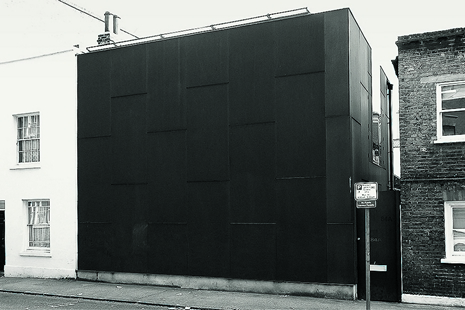
Elektra House, London
David Adjaye, 2005
Other juxtapositions associated with singular infill interventions include ‘houses beside houses’ in a manner that evokes architectural qualities of immediate context without replicating or literally emulating them. Juxtaposition can also extend to unexpected and unusual contrivances, like the projection of ‘houses that are not there’, in order to meet historic heritage or similar requirements within a residential neighborhood. An example of the first category of a ‘house beside a house’ is 302 Station Street or the Biles Residence in Melbourne, by Graeme Gunn Architects of 2003, constructed on a site sandwiched between old original terrace houses from the nineteenth century and a block of modern flats.
[5]
[6]
Moving on to ‘unit ensembles’ and ‘processes resulting in puntal interventions’, Space Block in the 36
th
[7]
[8]
[9]
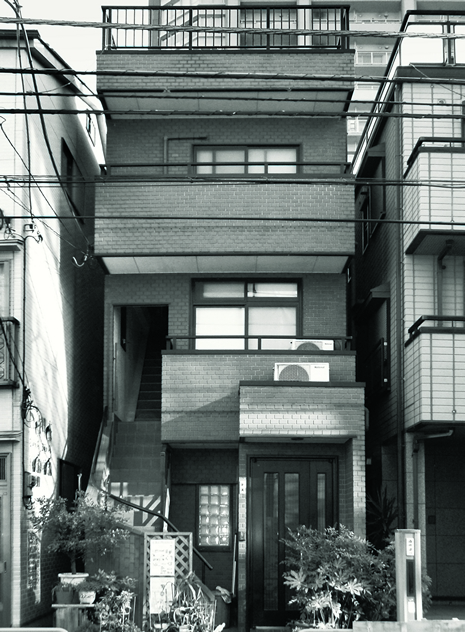
Tsukishima, Tokyo1990s
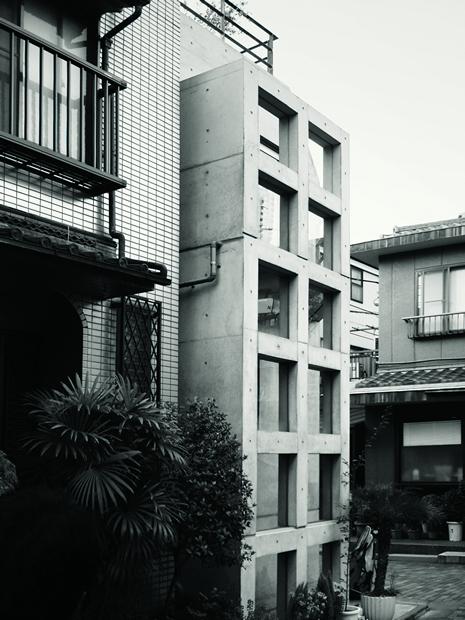
Tsukishima, Tokyo1990s
The phenomenon of small-scale block infills and redevelopment of small sites is probably most commonly found in Japan where the real estate market has been defined largely by countless small landholdings. A result of the strong private property rights and an inheritance policy of keeping the land within the same family across generations by subdividing it, these lots have typically been maintained by the same household or small businesses in the same location over time. Moreover, as documented by Atelier Bow-Wow’s “pet architecture”, the Japanese have found creative means of maximizing these minute and often unusually shaped parcels, transforming them into a variety of commercial, retail, and residential purposes. Much of this boom in small housing, whether in the form of single-family detached dwellings or collective configurations, occurred after the burst of the ‘bubble economy’ of the 1980s, gaining traction through the growing attention paid in architectural journals and popular magazines, as well as other types of media. With the dramatic drop in real estate values after the ‘bubble’ period, some of the relatively larger properties were sold by subdividing them into smaller lots to facilitate the sales, thereby encouraging the proliferation of these small and narrow homes, or
[10]
Two of the four single-family detached houses showcased here were designed by Atelier Bow-Wow, which seeks to engage with what the architects term ‘lively space’ through their architecture, while working within the pockets presented in a hyper-dense urban environment.
[11]
At the Sway House, Atelier Bow-Wow had a larger site of 78.08 square meters to work with but found themselves in a tight alley sandwiched between houses from the earlier post-war era. To be able to fit a parking lot on the site while also maximizing the solar insulation to this dense pack of residences lined along the alley, the architects bent and tapered the southern and western outer walls of the house, forming an incline and creating a ‘sway’-like appearance in the building envelope. In doing so, they were able to maximize the house’s overall capacity and at the same time comply with the city’s sky exposure regulation to ensure adequate sunlight to the street. The building footprint thus occupied a modest 39.14 square meters, or just barely half the site area. Built of wood and metal, the house is wrapped by horizontal panels of white, galvanized steel, and its slender form is further accentuated by several narrow, rectangular windows of various sizes dispersed in a seemingly random manner on the façades for natural lighting and ventilation purposes. As in the ACO House, a stepped section was employed to create floors and rooms of optimal heights, including a compressed kitchen and dining area of just 1.92 meters in height, and more commodious work and living areas ranging from 2.23 meters to 4.12 meters in height. The clients are a young couple in the art industry with the flexibility of working from home while taking care of their children, and thus it was important to have a clearer segregation of functions, with two nooks allocated as work spaces for each of them, and a living room as well as a children’s room on the top floor that are relatively more open with the elimination of internal walls. Storage spaces are cleverly hidden under benches in the living and dining rooms, while the incorporation of a spiral stairway located at the outer wall further increases the available floor area. Unlike the ACO House where the bedroom was located on the upper level, here the bedroom is situated on the ground floor just beyond the husband’s work space, while the rooftop terrace was reserved for an outdoor bathtub.
If the two projects by Atelier Bow-Wow project a sense of distinction between the public and private realms in terms of how the houses relate to the street, then House NA by Sou Fujimoto, completed in 2010, arguably represents their antithesis, blurring the boundaries between outside/inside, public and private. Constructed on a 54.47-square-meter site in the quiet neighborhood of Suginami, this three-dimensional matrix of suspended glass boxes stands as a daring, unconventional take on the
[12]
[13]
Lucky Drops or Skin House No. 7 by Yamashita Yasuhiro from Atelier Tekuto is another single family detached dwelling, also located in Setagaya-ku. With a building footprint of merely 21.96 square meters, this extraordinary project epitomizes the
Besides these standalone architectural gems, small-scale infills can likewise occur through the aggregation of dwelling units into collective housing. In Setagaya-ku, the Seijo Townhouse or the Garden Court Seijo United Cubes completed in 2007 by Kazuyo Sejima is an instance of an experimental undertaking not just by the architect but also by the developer that sought to offer an alternative way of providing condominium apartments within the dense urban fabric of Tokyo. The private developer had organized a competition in search of an architect to design a collective housing project that would attain a “site-specific atmosphere” as well as relate to the city.
[14]
[15]
Another collective housing sharing similar unit variation and individuation is the Umegaoka Cooperative Housing ROXI completed earlier in 2003 by Satoshi Sasaki from SGM Architect & Associates.
[16]
[17]
[18]
[19]
[20]
One final infill project that serves as collective housing is the Alfonso Reyes 58, situated in a vastly different context of the Colonia Condesa neighborhood in Mexico City. The dense residential neighborhood itself is an up-and-coming area with an assortment of restaurants and nightclubs popular amongst the young, white-collar professionals, artists, students, and intellectuals. Designed by Dellekamp Architects and completed in 2003, the complex houses seven units with commercial space and parking on the ground floor on a relatively small site of 390 square meters. Located at the edge of a perimeter block comprising traditional Mexican-style row houses, the reflective, aluminum-clad building of stacked boxes rises six storeys above grade. While this contemporary, rectilinear composition might at first glance seem like a stark contrast to the colorful plastered façades and effusive roofs of the low-rise row houses lining the secondary street, it in fact helps to give shape to the arterial road of Avenida Alfonso Reyes, much in line with the bright-red five-storey shophouse and the high-rise commercial building it is sandwiched between. Plan-wise, the architects retained the perimeter block nature of the site, creating a C-shaped structure enclosing a modest courtyard, buffering the high levels of noise emanating from the busy street. Starting from the ground floor, the variously sized boxes are overlapped at various points, creating rectangular and L-shaped voids on the sides as well as along the street façade, separating the apartments while creating interior patios and terraces. All the units are elevator-served and accessed via a central lobby; the four units on the third and fourth floors are configured at mirror opposites of each other, both vertically and horizontally, while the three units on the fifth and sixth floors are each unique in plan. In each of these units, the service spaces are pushed to the back, freeing up the space closer to the street fronts for living areas and allowing for ample light and air to enter through the slim bands of clerestory windows. Façade-wise, these apartments are also materially expressed with dissimilar finishes to their aluminum external cladding, differentiated by the two shades, and either smooth or corrugated surfaces. The floor-to-ceiling height extends 3.2 meters, with the cladding functioning as a screen wrapping around the boxes to retain the internal privacy as well as to block out the noise of the city, punctured occasionally by a few small windows. Overall, this urban insertion deploys a similar strategy to Sejima and Nishizawa, where disaggregated blocks can be assembled in a manner that reflects the individuality of each of the units, attaining a high diversity of unit types in a housing typology that has conventionally been associated with mass production and standardization in the modern age.
The purposes and outcomes of houses and housing deployed as puntal interventions can be varied. One set of outcomes concerns primarily the expressive interchange with adjacent or nearby buildings. Another set has to do largely with functional relationships, again within a neighboring context. A third set involves the relative ease of transferability from a very particular set of relationships to other housing and building types to those that are more general. The first set includes expressive purposes like animation, for instance, where a particular housing context is enlivened by the inclusion of a new addition, the appearance of which has reverberations beyond its immediate boundaries. Certainly, many of Tokyo’s small houses described here have this kind of effect. By contrast, another expressive purpose and outcome may be to complete, or sometimes round out, what is already in place, involving direct emulation of the formal and figural composition of adjacent buildings. Many extensions of terraces of row houses in various places have this quality to them. Indeed, the relative ease with which figural aspects of row house architecture can be rather completely changed without interfering unduly with the formal character of the basic housing type makes this sort of outcome possible. Then too, there can be a capacity for contradistinction, whereby sharp differences are drawn with neighboring properties, using basic characteristics that are shared in common, such as materiality, relative openness, and transparency, contemporaneity, or simply style. Again, the row house type can be conducive to this kind of expressive interplay.
A second set of outcomes, involving largely functional relationships with neighboring circumstances, can include facilitation of despecialization over time, where aspects of an original infill of housing become at least partially converted to support, say, storefront activities. This may be very important to the continuing quality of life of an otherwise residential neighborhood, as can conversion in an opposite direction from, say, light industrial to housing and commercial use to loft dwellings. Then, as a corollary to this despecialization of use, entirely new housing types can be introduced, as in Mexico City, with the aim of providing the opportunity to more actively transform a neighborhood. Many work-live arrangements within the broad categories of housing discussed here can have this effect. Provision of higher density is also a functional transformation that can occur with new infill and puntal interventions, as demonstrated in Tsukishima in Tokyo. Further, staying with Tsukishima and other places like it, a function of successive infill projects can be simply to legalize dwelling circumstances through needed construction modifications.
Finally, the third set of aims and outcomes are intertwined with similitude and replicability and concern the degree to which particular kinds of infill and puntal interventions can be made more broadly applicable elsewhere. Often, the sheer specificity of immediate contextual responses, as suggested by the other sets of purposes and outcomes, can limit replicability. Conceptually, replicability requires sufficient similarity between a given set of circumstances and those being potentially emulated. This may take the form of straightforward equivalence and one-to-one correspondence, as in the completion, for instance, of a row of townhouses. In other situations, like the House NA in Tokyo, for example, similitude, in this case concerned with the replication of certain traditional traits in housing, came by way of a certain parallelism and degree of analogy. Rather than a planar conjoint layout of space in the manner of traditional
Footnotes
Bunting Bainbridge, Houses of Boston’s Back Bay: An Architectural History, 1840–1917 (Cambridge, MA: Belknap Press, 1967)
Agnes Repplier, Philadelphia: The Place and The People (New York: Macmillan, 1898); and Charles Lockwood, Bricks & Brownstone: The New York Row House, 1783–1929 (New York, NY: Abbeville Press, 1972).
Dominique Vellay, La Maison de Verre: Pierre Chareau’s Modernist Masterwork (London: Thames & Hudson, 2007).
Rowan Moore, “Una Casa Per Elektra,” Domus 835 (March 2001): 60–71.
“302 Station Street,” in Infill: New Houses for Urban Sites, Adam Mornement and Annabel Biles (London: Laurence King, 2009), 20–23.
“Old House,” in Infill: New Houses for Urban Sites, 154–159.
Aurora Fernández Per, Javier Mozas and Javier Arpa, DBook: Density, Data, Diagrams, Dwellings: A Visual Analysis of 64 Collective Housing Projects (Vitoria-Gasteiz: a+t ediciones, 2007), 340–343.
Tokyo-tō Chūō-ku, “New Rules for Determining the Street Widths in the Tsukishima’s Machi Area”, (Tokyo: Tokyo-tō Chūō-ku Government, 1999) (in Japanese).
Personal conversation with Yoshida-san, then the Planning Director for Chūō-ku, Tokyo, March, 2003.
“Japan: Market Situation,” National Association of Realtors, accessed November 16, 2013, http://www.realtor.org/intlprof.nsf/92bfc17e61d4b65086256811004d5632/11b2499831c0a1db8625681000680edb?OpenDocument
“Atelier Bow-Wow – Japanese Pet Architecture,” designbuild-network.com, accessed November 16, 2013, http://www.designbuild-network.com/features/feature49404/
Sou Fujimoto, “Sou Fujimoto: House NA, Tokyo, Japan,” GA Houses 121 (May 2011): 146; “House NA/ Sou Fujimoto Architects,” archdaily, accessed November 16, 2013, http://www.archdaily.com/230533/house-na-sou-fujimoto-architects/
Fujimoto, “Sou Fujimoto: House NA, Tokyo, Japan,” 146.
Stefano Casciani and Kazuyo Sejima, “Kazuyo Sejima, Seijoville,” Domus 915 (June 2008): 35.
Casciani and Sejima, “Kazuyo Sejima, Seijoville,” 35.
“Umegaoka Cooperative House ROXI: SGM Architect & Associates, Tarao Hiiro Architects, Takehiko Higa Architect & Associates, Atelier-YY,” Japan Architect 56 (Winter 2005): 88–89.
Tarao Hiiro Architects, “Umegaoka Cooperative House ROXI A-unit,” accessed November 17, 2013, http://www.taraohiiro.co.jp/umegaoka/A-unit/A-unit.html
Tarao Hiiro Architects, “Umegaoka Cooperative House ROXI D-unit,” accessed November 17, 2013, http://www.taraohiiro.co.jp/umegaoka/D-unit/D-unit.html
Tarao Hiiro Architects, “Umegaoka Cooperative House ROXI H-unit,” accessed November 17, 2013, http://www.taraohiiro.co.jp/umegaoka/H-unit/H-unit.html
Tarao Hiiro Architects, “Umegaoka Cooperative House ROXI J-unit,” accessed November 17, 2013, http://www.taraohiiro.co.jp/umegaoka/J-unit/J-unit.html
Internal Links
Originally published in: Peter G. Rowe, Har Ye Kan, Urban Intensities: Contemporary Housing Types and Territories, Birkhäuser, 2014.